标签:队列 data 数据 队列实现 one str 大小 vat display
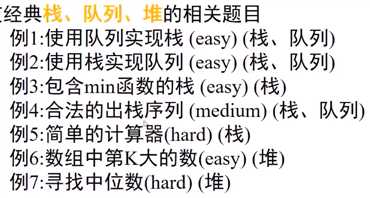

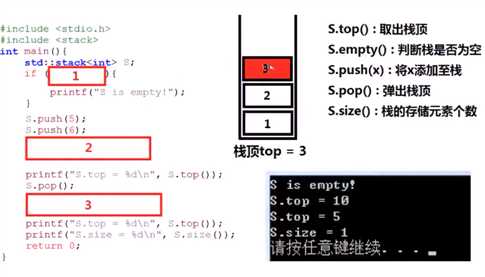

1 #include <iostream> 2 using namespace std; 3 4 #include <stack> 5 int main(){ 6 stack <int> stk; 7 if(stk.empty()){ //判断是否为空 isempty() 8 cout <<"The Stack is empty!!!"<<endl; 9 } 10 stk.push(5); //压栈 11 stk.push(6); 12 stk.push(10); 13 14 cout <<"The Stack‘ top is " <<stk.top()<<endl; 15 stk.pop(); //弹出栈顶 16 stk.pop(); 17 cout <<"The Stack‘ top is "<<stk.top()<<endl; 18 cout <<"The Stack‘ size is "<<stk.size()<<endl; //栈中的size 19 20 return 0; 21 }
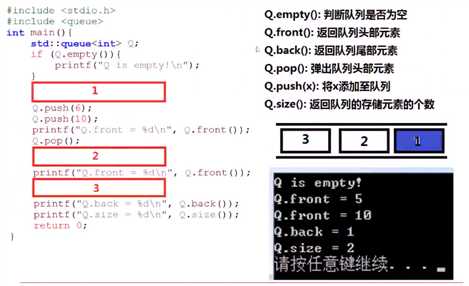

1 #include <iostream> 2 using namespace std; 3 4 #include <queue> 5 int main(){ 6 queue <int> quu; 7 if(quu.empty()){ 8 cout << "The Queue is empty!"<<endl; 9 } 10 quu.push(5); //加入队列 11 quu.push(6); 12 quu.push(10); 13 14 cout<<"The Queue‘ front is "<<quu.front()<<endl; 15 quu.pop(); //从队列头拿出 16 quu.pop(); 17 cout<<"The Queue‘ front is "<<quu.front()<<endl;//队头 18 quu.push(1); //队列后加入 1 19 cout<<"The Queue‘ back is "<<quu.back()<<endl; //队尾 20 21 22 cout<<"The Queue‘ size is "<<quu.size()<<endl; //队列的大小 23 24 return 0; 25 }
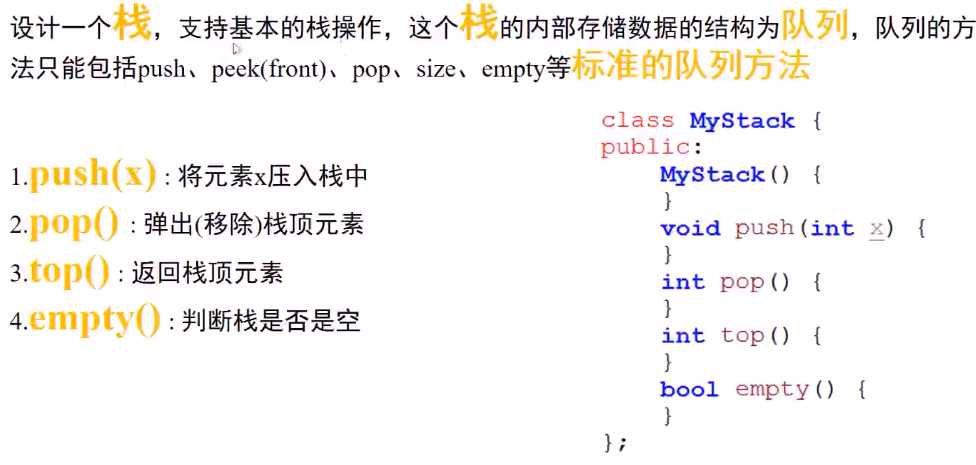
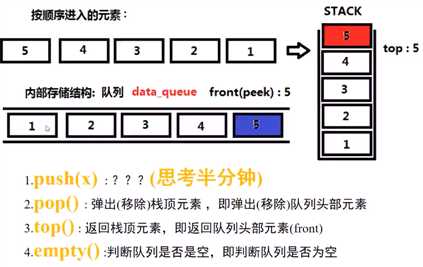
假设前4个已经调整好了,下面是如何调整第五个!!!
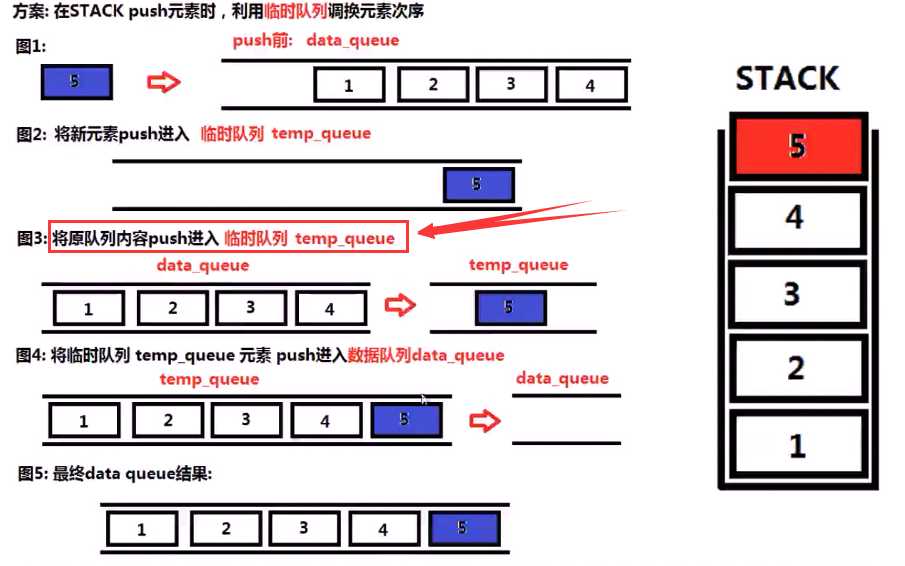

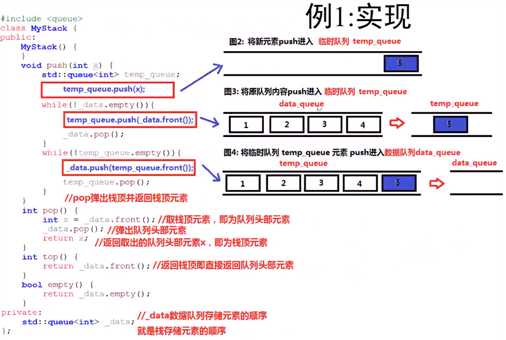
代码:

1 class MyStack{ 2 public: 3 MyStack(){} 4 void push(int x){ 5 queue <int> temp_queue; //临时队列 6 temp_queue.push(x); 7 while(!_data.empty()){ //将_data中的数据push 到临时队列 8 temp_queue.push(_data.front()); 9 _data.pop(); 10 } 11 while(!temp_queue.empty()){ //将 temp_queue中重新放入到_data中 12 _data.push(temp_queue.front()); 13 temp_queue.pop(); 14 } 15 } 16 17 int pop(){ 18 int x = _data.front(); 19 _data.pop(); 20 return x; 21 } 22 23 int top(){ 24 return _data.front(); 25 } 26 27 bool empty(){ 28 return _data.empty(); 29 } 30 private: 31 queue <int> _data; // _data中存储的是 栈存储的顺序 32 };

1 #include <iostream> 2 using namespace std; 3 4 #include <queue> 5 6 class MyStack{ 7 public: 8 MyStack(){} 9 void push(int x){ 10 queue <int> temp_queue; //临时队列 11 temp_queue.push(x); 12 while(!_data.empty()){ //将_data中的数据push 到临时队列 13 temp_queue.push(_data.front()); 14 _data.pop(); 15 } 16 while(!temp_queue.empty()){ //将 temp_queue中重新放入到_data中 17 _data.push(temp_queue.front()); 18 temp_queue.pop(); 19 } 20 } 21 22 int pop(){ 23 int x = _data.front(); 24 _data.pop(); 25 return x; 26 } 27 28 int top(){ 29 return _data.front(); 30 } 31 32 bool empty(){ 33 return _data.empty(); 34 } 35 private: 36 queue <int> _data; // _data中存储的是 栈存储的顺序 37 }; 38 39 40 41 int main(){ 42 MyStack * stk = new MyStack(); 43 stk->push(2); 44 stk->push(4); 45 stk->push(8); 46 int a = stk->pop(); 47 int b = stk->top(); 48 bool c = stk->empty(); 49 cout <<a <<b<<c<<endl; 50 51 return 0; 52 }
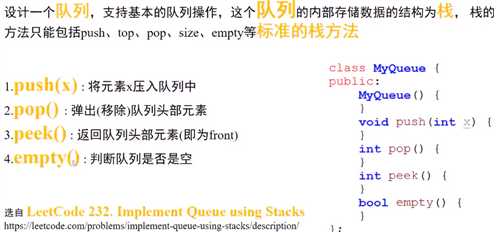
思路及代码:

和例1一样,先假设已经有了四个元素,现在准备插入第五个元素,就是如何将5 放到栈的最下面!!!
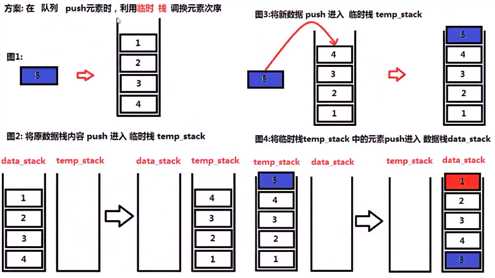
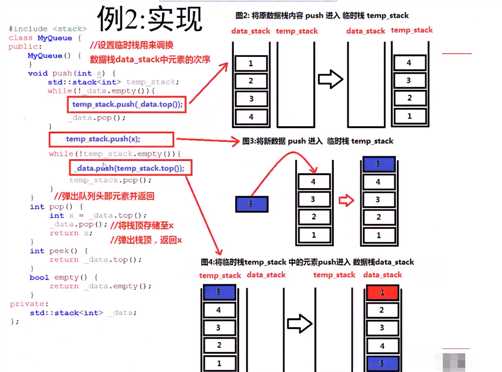

1 class MyQueue{ 2 public: 3 MyQueue(){} 4 void push(int x) { 5 //先将原有的栈中元素都出栈 进入临时栈中 temp_stk 6 stack <int> temp_stk; 7 while(!_data_stk.empty()){ 8 temp_stk.push(_data_stk.top()); 9 _data_stk.pop(); 10 } 11 _data_stk.push(x); //将要加入的放到临时栈中 12 while(!temp_stk.empty()){ //最后再将临时中的元素全部转回到data_stack中 13 _data_stk.push(temp_stk.top()); 14 temp_stk.pop(); 15 } 16 } 17 18 int pop(){ 19 int x = _data_stk.top(); 20 _data_stk.pop(); //返回类型是void 21 return x; 22 } 23 int peek(){ //front 24 return _data_stk.top(); 25 } 26 bool empty(){ 27 return _data_stk.empty(); 28 } 29 30 private: 31 stack <int> _data_stk; 32 };

1 #include <iostream> 2 using namespace std; 3 4 #include <stack> 5 6 class MyQueue{ 7 public: 8 MyQueue(){} 9 void push(int x) { 10 //先将原有的栈中元素都出栈 进入临时栈中 temp_stk 11 stack <int> temp_stk; 12 while(!_data_stk.empty()){ 13 temp_stk.push(_data_stk.top()); 14 _data_stk.pop(); 15 } 16 _data_stk.push(x); //将要加入的放到临时栈中 17 while(!temp_stk.empty()){ //最后再将临时中的元素全部转回到data_stack中 18 _data_stk.push(temp_stk.top()); 19 temp_stk.pop(); 20 } 21 } 22 23 int pop(){ 24 int x = _data_stk.top(); 25 _data_stk.pop(); //返回类型是void 26 return x; 27 } 28 int front(){ //peek() 29 return _data_stk.top(); 30 } 31 bool empty(){ 32 return _data_stk.empty(); 33 } 34 35 private: 36 stack <int> _data_stk; 37 }; 38 39 40 int main(){ 41 42 return 0; 43 }
思路及代码:
思路及代码:
标签:队列 data 数据 队列实现 one str 大小 vat display
原文地址:https://www.cnblogs.com/zach0812/p/11787486.html